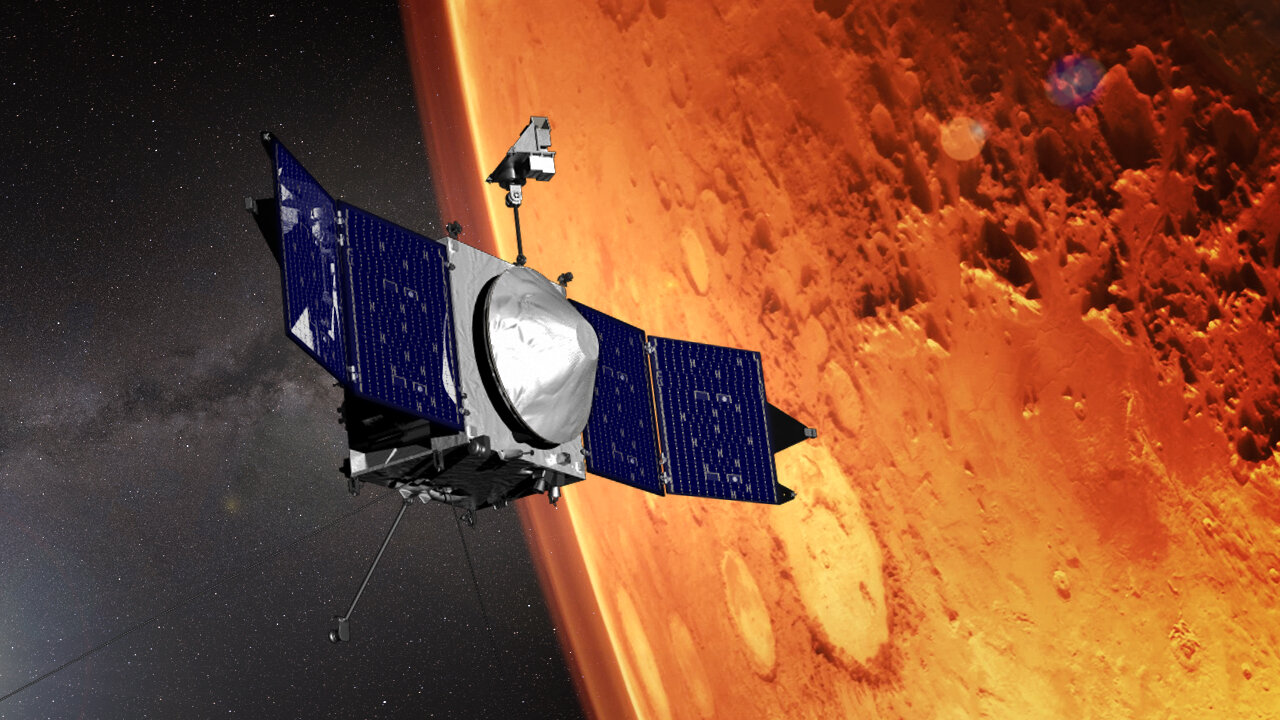A navigation glitch on NASA's Mars orbiter MAVEN has stalled its science work
The MAVEN orbiter's main antenna is pointed toward Earth as it recovers, limiting science operations.

A navigation system glitch that struck NASA's MAVEN orbiter at Mars earlier this year has hobbled the spacecraft's ability to conduct science and study the Red Planet's atmosphere.
The MAVEN spacecraft, which has orbited Mars since 2014, went into a protective "safe mode" on Feb. 22 when its vital inertial measurement units "began exhibiting anomalous behavior," NASA officials wrote in a May 18 update. While in safe mode, a spacecraft shuts down all science and awaits instructions from its flight controllers on how to recover.
In the weeks that followed, NASA managed to revive MAVEN from safe mode, but in a limited capacity. The orbiter is in a stable orbit with its primary antenna pointed at Earth to maintain high-rate communications with its flight control team.
"In this configuration, however, MAVEN cannot perform communications relays for other spacecraft on Mars and is performing only limited science observations," NASA officials wrote in the update. "The mission team began science instrument recovery on April 20." The orbiter normally serves as a communication relay for NASA's Curiosity rover and Perseverance rover on Mars to beam the latest images and research from the Martian surface to Earth.
Related: A brief history of Missions to Mars
MAVEN's inertial measurement unit (IMU) system relies on ring laser gryroscopes, that detect the spaceraft's inertial motion, and four reaction wheels arranged in a four-sided pyramid that can spin independently to position the orbiter in the proper orientation, according to a NASA press kit. The orbiter is also equipped with two star tracker cameras that can take images of stars and feed them into a stellar detection algorithm to help the spacecraft determine its orientation in space.
NASA officials reported that MAVEN was in safe mode until April 19, when flight controllers switch the spacecraft from its IMUs to the star-tracking system in what is known as "all-stellar mode."
Get the Space.com Newsletter
Breaking space news, the latest updates on rocket launches, skywatching events and more!
"All MAVEN's science instruments are currently online, but not all of them have been able to take data while the high gain antenna is restricted to pointing toward Earth," NASA officials wrote in the update. "The team is currently working to finish checkouts of 'all stellar' mode to enable the spacecraft to operate in other orientations prior to resuming nominal science and relay operations by the end of the month."
NASA launched the MAVEN mission (its name is short for Mars Atmosphere and Volatile EvolutioN mission) in November 2013 and arrived at the Red Planet in October 2014. Its mission is to study how Mars lost its surface water to become the dusty red world we see today. Last month, NASA extended the MAVEN mission, which originally cost $671 million, by another three years to allow the orbiter to continue its science work.
Email Tariq Malik at tmalik@space.com or follow him @tariqjmalik. Follow us @Spacedotcom, Facebook and Instagram.
Join our Space Forums to keep talking space on the latest missions, night sky and more! And if you have a news tip, correction or comment, let us know at: community@space.com.

Tariq is the Editor-in-Chief of Space.com and joined the team in 2001, first as an intern and staff writer, and later as an editor. He covers human spaceflight, exploration and space science, as well as skywatching and entertainment. He became Space.com's Managing Editor in 2009 and Editor-in-Chief in 2019. Before joining Space.com, Tariq was a staff reporter for The Los Angeles Times covering education and city beats in La Habra, Fullerton and Huntington Beach. In October 2022, Tariq received the Harry Kolcum Award for excellence in space reporting from the National Space Club Florida Committee. He is also an Eagle Scout (yes, he has the Space Exploration merit badge) and went to Space Camp four times as a kid and a fifth time as an adult. He has journalism degrees from the University of Southern California and New York University. You can find Tariq at Space.com and as the co-host to the This Week In Space podcast with space historian Rod Pyle on the TWiT network. To see his latest project, you can follow Tariq on Twitter @tariqjmalik.









